
16
CARBON FIBER SERIES
CRADLE RINGS
(The following section does not apply to the 80mm model, as it does not include or need
a cradle ring. Instead, the 80mm has a vixen dovetail plate attached directly to the OTA.)
To attach the 102mm, 127mm or 152mm model to a mount you will need to use the
individual model’s included cradle ring set.
Engineered to snugly grip its particular telescope, each extruded aluminum cradle
assembly includes a hinged ring system, a slotted carry handle and a felt-lined interior
that protects the tube’s delicate surface. The rings are attached to a saddle plate to
secure your scope to a mount. The cradles for the 102mm and 127 models have vixen
dovetail plates, while the 152mm model has a Losmandy-style plate. To attach cradle
rings to your OTA, release the locking mechanism on each ring. On the 102mm model,
the locking mechanism consists of a metal bar capped with oversized thumbscrews.
At the point where each half of the ring meets, simply flip the bar over and tighten the
thumbscrews. The 127mm and 152mm models have an easy-to-operate latching lock
mechanism. If you are only repositioning the tube, you probably will not need to remove
the assembly completely. Instead, you can undo the lock on each ring so that the tube is
loose enough in the rings to slide back and forth or rotate. Be careful to hold the tube
securely so that you do not lose control of it while the cradle rings are loose. Once the
tube is in the desired position, be sure to retighten each lock. Finding the right placement
of the cradle ring assembly involves finding your individual scope’s balance point, which
depends largely on the accessories you will be using.
Before attempting to find this point, you should make sure the diagonal and/or any heavy
attachments like cameras or large eyepieces are installed. On the models with vixen
dovetail saddle plates attached to the cradle rings, you may need to make adjustments
for cone error if you are using a German equatorial mount. Cone error occurs when the
polar axis of your mount and the center of your telescope’s optical axis are not aiming at
the same point in the sky. To check for cone error, you will need to first line your mount
up with a fairly fixed point in the sky like Polaris or a stationary terrestrial target that will
be far enough away to see well in your telescope. Mount your telescope and see if it is
centered on the same target. If it is not, you will need to take the scope off of the mount
and slightly tilt the telescope tube away from or toward the saddle plate by threading the
adjusting screws in or out. These screws flank a central locking screw on each end of the
Defocused and focused
out-of-collimation
star images (1 and 2
Defocused and focused
properly collmated
star images (3 and 4)
Figure 1
1
3
2
4
Summary of Contents for TWILIGHT Series
Page 1: ......
Page 33: ...33 NOTES ...
















































